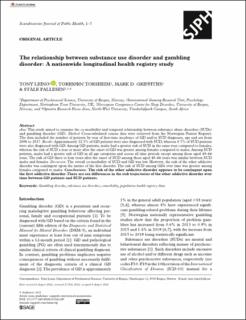The relationship between substance use disorder and gambling disorder: A nationwide longitudinal health registry study
Journal article, Peer reviewed
Published version

Åpne
Permanent lenke
https://hdl.handle.net/11250/2979587Utgivelsesdato
2021Metadata
Vis full innførselSamlinger
Sammendrag
Aim: This study aimed to examine the co-morbidity and temporal relationship between substance abuse disorders (SUDs) and gambling disorder (GD). Method: Cross-tabulated census data were retrieved from the Norwegian Patient Registry. The data included the number of patients by year of first-time incidence of GD and/or SUD diagnoses, age and sex from 2008 to 2017. Results: Approximately 22.5% of GD patients were also diagnosed with SUD, whereas 0.7% of SUD patients were also diagnosed with GD. Among GD patients, males had a greater risk of SUD in the same year compared to females, whereas the risk of SUD a year or more after the onset of GD was greater among females compared to males. Among SUD patients, males had a greater risk of GD in all age categories and across all time periods except among those aged 40–66 years. The risk of GD three to four years after the onset of SUD among those aged 40–66 years was similar between SUD males and females. Discussion: The overall co-morbidity of SUD and GD was low. However, the risk of the other addictive disorder was contingent upon the nature of the first disorder. The risk of SUD among GDs over time was greater among females compared to males. Conclusions: The risk of the other addictive disorder appears to be contingent upon the first addictive disorder. There are sex differences in the risk trajectories of the other addictive disorder over time between GD patients and SUD patients.
